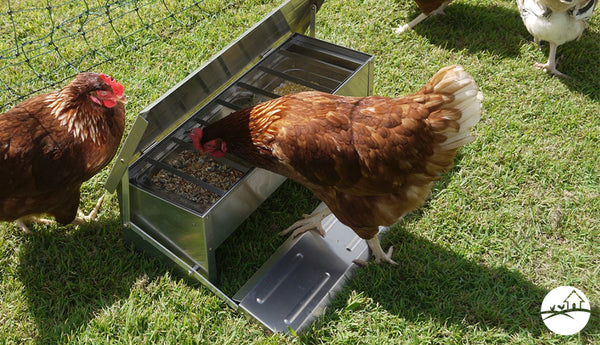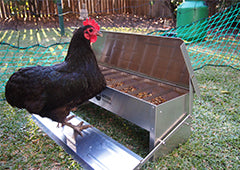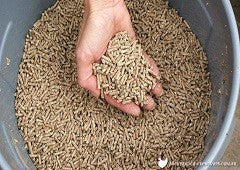There comes a time in a chicken owners life, as they scatter pellets or feed around the coop, when they begin thinking to themselves- ‘what is actually in this chicken feed?’ The science of creating chicken feed is actually quite a sophisticated process and it isn’t as simple as adding a few different types of grains into an oversized laundry basket and giving it a shake. If you’re the type of person who wants their chickens to be happy, healthy and productive layers, it’s essential that their feed is top notch. However, if you bravely wish to explore, experiment and expand your understanding of chicken feed by making your own, it’s important that you take note of a few important things first.
What are the cornerstones of a chickens diet?
Like humans, chickens require a balanced, nutrient filled diet. The five cornerstones of a healthy chickens diet are:
-
Water: chickens drink almost double the amount of feed they eat- so make sure they have access to fresh water at all times.
-
Protein: to help them grow, produce feathers, lay eggs- protein is essentially the building blocks for everything we love about chickens.
-
Carbohydrates: great for energy, keeps their bodies moving and active.
-
Fat: gives chickens a required energy boost, also helps spread micronutrients across the body- plus it makes the food taste great.
-
Minerals and vitamins: these are like the little things you don’t think about that makes life run smoothly- you may only realise they are lacking when something goes very wrong.
Essentially, with the exception of water, your chicken can get most of their vital nutrients from a well-balanced chicken feed. Keep these five things in mind if you are planning on creating your own chicken feed, as each component of a chickens diet is as important as the other.
Why make your own chicken feed in the first place?
Many chicken lovers are caring environmentalists at heart- so it only seems natural that they want to understand what their beloved chickens are eating. Making your own chicken feed is a great way to ensure that what your lovely chooks are pecking at is organic, natural and prepared with love. Additionally, some chicken enthusiasts are committed to ‘living green’, and preparing your own quality chicken feed is a egg-cellent way to make your lifestyle that little bit more sustainable!
It is important to realise that food scientists have conducted significant and serious research in order to create high quality store bought chicken feed. These products are often created to ensure that the chickens continue to live healthy and happy lives, which often results in more delicious eggs for the owner. So, rest assured- as long as you are buying quality chicken feed, it is likely that your chickens will be consuming the vital nutrients that their bodies require. In other words, store bought chicken feed isn’t the equivalent of eating fast food for every meal- most are egg-ceptionally good for your flock.
How do I switch from store bought to organic homemade chicken feed?
It’s important that you don’t spring your new chicken feed on your flock without giving them time to adjust. A good idea would be to slowly integrate the new chicken feed you have created into the chooks diet over a couple of weeks and monitor how they react to it. What you are going to need to observe over this time is:
-
Changes in behaviour: are they sluggish, tired or generally behaving unusually?
-
Changes to their eggs: has egg production increased or decreased? How have the quality of the eggs changed?
-
Changes in their droppings: are the chickens droppings regular? Do they have diarrhoea? Could they possibly be constipated?
-
How do they respond to the food: are they more excited at feeding time? Are they reluctant to eat the new feed? Are there components of the chicken feed, like certain grains, that they are leaving to one side?
It’s vital that you spend eggstra time with your flock over the course of changing their chicken feed, just to be sure that you’re chickens are responding positively to their new menu. Over the course of these few weeks you should make adjustments to your new chicken feed to ensure that their diet isn’t out of proportion. For example, if their eggs are malformed, it’s probably a good idea to ensure that you include more calcium in their feed. Another issue might be that their feather production slows or they may start moulting uncharacteristically. This could be a sign that your homemade chicken feed doesn’t have the right combination of proteins. In short, make tweaks and be sure to do your research.
So long as you gradually integrate your own chicken feed into your flocks diet, it’s unlikely that you can inadvertently cause any harm to your beloved girls.

Where do I begin?
Generally speaking the process of creating your own chicken feed is relatively easy. So long as you have some airtight containers for storage and a larger container to mix the feed in, it’s unlikely that you’ll run into much trouble. Just ensure that the ingredients are fresh and edible and that you’ve mixed all the components through thoroughly. Other than that, the method of combining your chicken feed is relatively straight forward.
The tricky part however is deciding on the ingredients- the combinations are endless! Below are two recipe guides from other poultry aficionados to give you an idea of how to create your own chicken feed.
Recipe One
Ingredients
4 parts oat groats
4 parts black oil sunflower seeds
4 parts hard red wheat berries
2 parts soft white wheat berries
2 parts kamut
2 parts millet
2 parts whole corn
1 part lentils
1 part sesame seeds
1 part flax seeds
1/2 part brewer’s yeast
1/4 part kelp granules
Free-choice oyster shells
Free-choice grit
Recipe Two
Ingredients:
2 parts whole corn
3 parts soft white wheat
3 parts hard red winter wheat
½ part Diatomaceous Earth (not the kind you put in your pool)
1 part hulled barley
1 part oat groats
2 part sunflower seeds
½ part peanuts
1 part wheat bran
1 part split peas
1 part lentils
1 part quinoa
1 part sesame seeds
1/2 part kelp
Making your own chicken feed can be a fun and rewarding experiment for you and your chickens. It’s important however that you are prepared to invest the time and energy necessary to ensure that your marvelous concoction is received well by your flock. Ultimately, so long as you are committed to understanding the dietary requirements of your chickens, as well as being able to commit enough time into monitoring your chickens reaction to the new feed, you should be able to create your own unique, wonderful and organic chicken feed soon enough.
There is plenty of information at your disposal on our Backyard Chickens Learning Centre. So, if you want to learn more about chicken feed, your flocks dietary requirements, and foods you can treat your chooks with- you’re only a click away.
Store-bought or homemade, preparing nutritious mealtimes for optimal chicken health can be stressful and confusing. Many health issues experienced by our girls are due to an imbalanced diet. You might find yourself asking: what to feed, when to feed, how to feed, and why?!
Cluckily, there is no need to be overwhelmed by all the options because our friends at Chickenpedia can help you find out what’s best for your flock at all ages. This is why I recommend their Feeding Peckish Chickens course to all my readers. Through their course, unearth nutrient-rich foods to help your chickens stay healthy, live longer, and produce the best eggs. Keep those yolks nice and yellow! The course shares advice and information on the best food for your flock as well as quantity control, storage, and timing for feeds.
Feeding time is also a great one for entertainment and this course provides bonus content filled with DIY boredom busters, toys, and treats for your flock. Become an eggspert and gain the confidence needed to choose the right chicken feed and know which ones to avoid.
Be sure to click here to visit Chickenpedia today to check out ALL of their amazing courses.


















